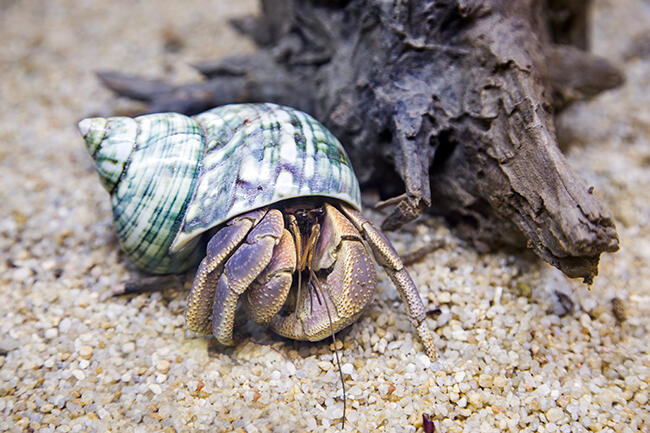By Stacy Mantle
If you’re like many people, when you think of an in-home aquarium keeping, you envision a tank filled with colorful fish. However, not every hobbyist, whether casual or dedicated, opts to keep fish—or only fish. Many keep other aquatic species (e.g., crustaceans, mollusks, frogs, corals, etc.) in community tanks or in dedicated setups. What follows are just four of the myriad species you could keep in an aquarium and their basic care requirements.
No matter which species you choose, each will have specific requirements that need to be met in order to ensure that they thrive. Before selecting any animal, remember to consider the following:
- Care level: Only select those that match your care abilities. Some species that require intensive care are better suited for more experienced keepers.
- Hardiness: some can thrive in most environments while others are more delicate, requiring very specific conditions
- Species size: Knowing how large a species can grow will help you determine tank size and bioload (e.g., how many it can accommodate).
- Compatibility/temperament: Not all species get along or thrive in the same environment. Some are passive, some are aggressive and others fall in-between. Always research which species can live together.
- Tank size and water depth: You need to ensure there is enough water volume to handle the bioload adequately. In addition, some fish prefer at the bottom of a tank, others prefer mid-tank or closer to the surface. You will need to ensure the tank meets each species’ needs.
- Diet: Will the species need a specialized diet or will it accept most commercially prepared foods
- Water parameters: You must ensure that the temperature, pH, hardness (kH), salinity, etc., are within an acceptable range for the species you keep.
- Preferred substrate: Depending on the species, a tank might need to have a bare bottom, rocky soil, sand, pebbles or a combination of one or more, such as sand with rocky areas.
- Lighting: Most animals require light to survive. For example, corals need strong light and some amphibians need 8 to 10 hours of full spectrum lighting.
Hermit Crabs
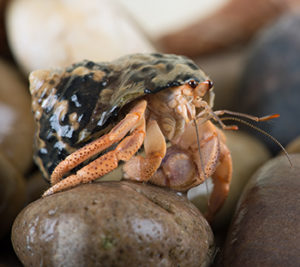
©Yanukit/Adobe Stock
Depending on the species, hermit crabs either live in a shoreline or ocean environment. Those that dwell on land require very little care. And while these gentle creatures don’t require a lot of room, they should have at least a 10-gallon tank for a pair of them to explore. Hermit crabs shed their skin and move into new, larger shells as they grow. You need to provide three to five larger empty seashells per crab so that they can move into them without any problems. When they begin molting, hermit crabs prefer to be alone and away from their tankmates because they are at their most vulnerable.
- Care level: Beginner
- Temperament: Peaceful, prefer to be left alone
- Life expectancy: Up to 10 years
- Tank requirements: 5+ gallons per animal (so two would require at least a 10-gallon aquarium). They live on land, but require water and moisture to replenish shell water.
- Lighting: Requires a fluorescent or LED bulb (not UVB) lighting for 8 to 12 hours a day.
- Air temperature: It should be between 78–85 degrees F during day and 65–75 degrees F at night.
- Humidity: It should remain between 70–80 percent; misters and a hygrometer can help you ensure you maintain this level.
- Diet: Pellet food crushed into powder, dark, leafy vegetables (kale, broccoli) and some fruits (apple, banana, grape). Remove any leftover food after 12 hours. These animals are very sensitive to metal, so be sure all dishes and aquariums are ceramic or a nonmetal, non-porous material.
African Dwarf Frogs
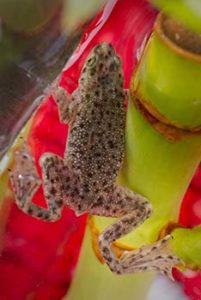
Source: CDC Public Health Image Library
These clever amphibians are completely aquatic and breathe air at the water’s surface. They may enjoy having a few tropical fish to swim with, but do not require them. If you forget to feed them, they might help themselves to your fish. As such, you should exercise caution when adding other animals.
- Care level: Intermediate
- Temperament: Active and shy
- Species size: Adults are approximately 3 inches
- Lifespan: 10 to 15 years
- Tank requirements: Screened or lit aquarium hoods are critical to keep them in their tank. If keeping one or two dwarf frogs, they can live happily in a 10-gallon aquarium that is away from busy areas and out of direct sunlight.
- Lighting: They require 8–12 hours of light per day and the water tropical (68–78 degrees F).
- Water temperature: 72–78 degrees F
- Water pH:5–7.5
- Diet: These omnivores can be given sinking pellets and frozen or live brine shrimp, bloodworms or tubifex worms
Corals
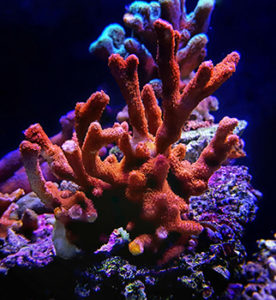
©Kolevski.V/Adobe Stock
Starting a reef aquarium is complex endeavor. They have very strict parameters and require careful monitoring of water quality, specialized equipment, varied diets, specific lighting and a lot of patience. In order to thrive, corals need sufficient light and stable water conditions and nutrients. Whether you’re setting up a completely new system or adding coral your existing saltwater aquarium, you can choose from stony and soft corals, depending on your setup and goals. Before starting out, you should consider joining one or more online groups that focus on reefkeeping. Experienced reefkeepers are your best resource for solving problems and sharing a love of these beautiful animals and the ecosystems they create.
- Care level: Intermediate to advanced
- Temperament: Semi-aggressive
- Life expectancy: Varies depending on species kept
- Tank requirements: Tank size will vary, depending on number and type of species kept and your experience level.
- Water temperature: 76–83 degrees F
- Water pH:8–8.5 (8.1–8.3 preferred)
- Lighting: Typically require strong lighting, some soft corals require less intensive levels
- Diet: It can vary depending on the species kept; food examples include phytoplankton, rotifers, krill, etc.
Jellyfish
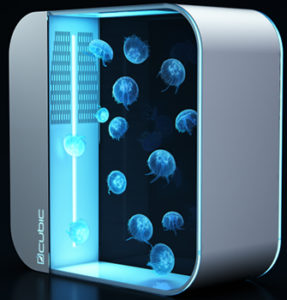
Jellyfish are incredible creatures to watch. And while jellyfish husbandry is still relatively new; hobbyists successfully keep them.The most commonly kept jellyfish are moon jellies and blue blubber jellies—there are other species currently available. Most other jellyfish are very difficult to keep in captivity in a home environment. All jellyfish require a specific type of tank that provides a circular water flow, has little to no suction (so they aren’t sucked into the filter) and does not produce air bubbles (i.e., no aeration). Fortunately, there are jellyfish tank kits that meet all of these requirements.
- Care level: Advanced
- Life expectancy: 2–3 years
- Tank requirements: Sizes vary, but requires a specialty tank that provides circular water flow
- Lighting: no specific requirements, but actinic blue lighting is frequently used to illuminate the jellyfish.
- Water temperature: 66–76 degrees F
- Water pH:6–8.5 (8.0 to 8.2 for moon jellies)
- Diet: plankton, brine shrimp, jellyfish-specific commercially prepared foods
About the Author: Stacy Mantle is a fulltime freelance writer, bestselling author and founder of PetsWeekly.com. She resides in the deserts of the Southwest with a few dogs, several cats and a very understanding husband.




